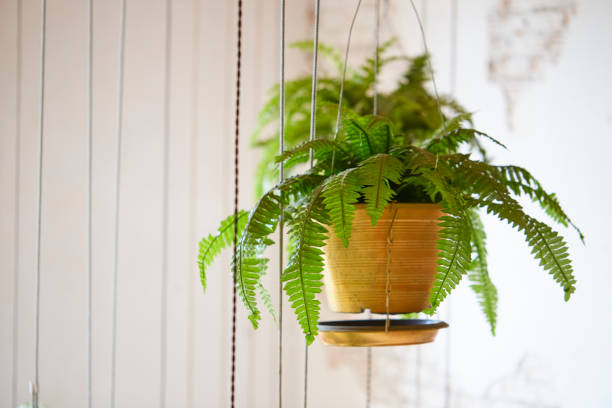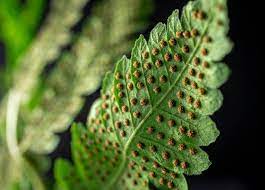Helpful Guides on each Category

Being the most popular variety among thousand of other ferns, the Sword Fern (Polystichum munitum) is a very rich addition to a garden. Mostly found in wild woody but wet areas, their beauty has spread indoors as more homes grow this plant in pots, planters and containers at home.
It is called sword fern because of its long, lush vibrant green foliage, and its pointed fronds that gracefully arch outward and reach 6 feet (2 metres) long creating a captivating visual appeal.
As for its native habitat and distribution, the Western Sword Fern thrives in damp and shaded areas. It can be commonly spotted in forests, along riverbanks, and in other moist environments. This fern is widespread across different regions, making it a familiar sight in many parts of its natural range.
The key characteristics of the plant and its foliage make it easily recognizable. Its active growth and ability to adapt to different environments contribute to its popularity among gardeners and nature enthusiasts alike. The Western Sword Fern’s foliage adds an enchanting touch to any landscape, enhancing the overall aesthetic appeal.
| Common Name | Western sword fern |
| Botanical Name | Polystichum munitum |
| Family | Dryopteridaceae |
| Plant Type | Evergreen, Fern, rhizome |
| Full Grown Size | 4-6 ft. tall, 2-4 ft. wide (outdoors); 1-4 ft. tall, 1-2 ft. wide (indoors) |
| Sun Exposure | Partial sun, shade |
| Soil Type | Loamy moist but well-drained soil |
| Soil pH | Neutral to Acidic |
| Water requirement | Moderate |
| Temperature | 60°F-75°F (15°C-24°C) |
| Toxicity | Non-toxic |
| Maintenance | Low Attention |
| Hardiness Zones | USDA 3 to 9 |
| Native Area | North America |
| Garden Uses | Border plants, Grond covers |
Choosing the Right Indoor Location for Western sword fern

For best results as you care for your Sword Fern (Polystichum munitum) indoors, it is essential to provide them with the ideal indoor conditions.
Potting and Soil for planting Sword Ferns Indoor
Select a pot that provides enough space for the fern’s root system to grow.
A pot with a diameter of about 1.5 to 2 times the width of the fern’s spread is generally sufficient. This size allows the plant to establish its roots comfortably without being too constrained.
In terms of material, use breathable and porous materials such as clay, terracotta, or ceramic. These allow excess moisture to evaporate, preventing waterlogged soil and potential root rot. Avoid pots made of non-porous materials like plastic, as they can trap moisture and lead to unhealthy soil conditions.
Choose pots with drainage holes at the bottom to facilitate water drainage. If you have fallen in love with a pot without drainage holes, you can place the fern in a plastic nursery pot with drainage holes inside the decorative pot. This way, you can water the fern thoroughly, allow excess water to drain, and then discard any standing water in the decorative pot.
Soil Mix for Western Sword Fern
Sword Ferns thrives in a well-draining and moisture-retentive soil mix. An ideal soil mix consists of equal parts of peat moss, perlite, and potting soil.
The peat moss helps retain moisture, while perlite provides aeration and prevents compaction. The potting soil provides essential nutrients for the fern’s growth.
Mix the components thoroughly before planting the fern in the pot, ensuring an even distribution of moisture and nutrients throughout the soil.
How to grow Western Sword Fern Indoors
Propagating Sword Fern from Spores

This is a fascinating and rewarding way to expand your fern collection. Unlike traditional plant propagation through cuttings or divisions, ferns reproduce through spores, which are tiny reproductive cells found on the undersides of their fronds. When spores mature, they can be collected and used to grow new ferns.
1. Collect Spores
- Look for mature fronds on the sword fern. Mature fronds will have sori, which are small clusters of spore-containing structures on the undersides of the fronds.
- To collect spores, gently cut a mature frond from the fern using clean and sharp scissors. Place the frond, with the spore-bearing side facing down, on a piece of white paper or a glassine envelope. Allow the frond to dry for a few days until the spores are shed onto the paper.
2. Prepare a Growing Medium
- Use a sterile and well-draining growing medium for planting the spores. A mix of peat moss, perlite, and vermiculite can work well. Moisten the medium, but avoid making it waterlogged.
3. Sow the Spores
- Once the spores are shed onto the paper, carefully transfer them onto the moistened growing medium. Lightly sprinkle the spores over the surface without clumping them together. Do not cover the spores with soil, as they require light to germinate.
4. Create a Greenhouse Effect
- Cover the pot or container with clear plastic or a transparent lid to create a mini greenhouse that retains humidity. This will help create the moist and humid conditions necessary for spore germination.
- Place the pot in a location with bright, indirect light. Avoid direct sunlight, as it can dry out the spores and disrupt germination.
- Spore germination can take several weeks to months, so be patient. Keep the growing medium consistently moist, but not waterlogged.
- As the new ferns begin to grow, they will develop tiny heart-shaped gametophytes. These young ferns will eventually grow into recognizable fern plants.
Propagation through spores can be a bit more challenging than other methods, but with patience and care, you can enjoy the rewarding experience of successfully propagating sword ferns and watching them grow from tiny spores into beautiful plants.
Sword Fern Care

Temperature
Western Sword Ferns prefer moderate temperatures ranging from 60°F to 75°F (15°C to 24°C). Avoid exposing them to extreme temperature fluctuations, as it can stress the plant. Keep the fern away from drafty windows, heating vents, or air conditioning units.
Light
Place the fern in a location with bright, indirect light. Avoid direct sunlight, as it can scorch the delicate fronds. If bright light is not available, the fern can tolerate low light conditions, but it may grow more slowly.
Soil
Use a well-draining potting mix suitable for ferns. An ideal mix can include equal parts peat moss, perlite, and potting soil. This blend provides good aeration and moisture retention for the plant’s roots. The soil should be moist and well-drained to avoid water logging.
Watering and Humidity
Water the fern when the top inch (2.5 cm) of the potting mix feels dry to the touch. Stick your finger into the soil to check for moisture before watering. Avoid overwatering, as this can lead to root rot.
Yellowing or wilting fronds, foul odour from the soil, and soggy or waterlogged appearance are signs of overwatering.
Dry, crispy fronds and extremely dry soil are signs of underwatering.
Fertilizer
Western Sword Ferns generally have modest nutrient requirements. They do not need heavy feeding like some other plants. Use a balanced liquid fertilizer or a specialized fern fertilizer. Look for one with an NPK ratio (nitrogen-phosphorus-potassium) of around 10-10-10 or a similar balanced formulation.
During the active growing season in spring and summer, fertilize the fern every two to four weeks. In fall and winter, reduce or suspend fertilization as the plant’s growth slows down.
Pruning and maintaining Sword Fern Plant

Trim Old Fronds and Yellow Leaves
- Regularly inspect your fern for any old or discoloured fronds. These fronds are no longer contributing to the plant’s vitality and can be pruned to promote new growth and aesthetics.
- Using sharp and clean pruning shears or scissors, carefully trim the fronds close to the base of the plant. Avoid cutting into the crown (the central growing point) of the fern, as it can harm the plant.
- Besides removing old fronds, you can also selectively prune the fern to shape it and encourage healthy growth.
- If you notice any fronds that are becoming too large or overgrown, you can trim them back to maintain the fern’s desired size and appearance.
- Cut back any crowded areas where fronds may be competing for light and space.
- Dust can accumulate on the fern’s fronds, hindering its ability to photosynthesize efficiently. Regularly dust the fronds to keep them clean and dust-free.
- Gently wipe the fronds with a soft, damp cloth or sponge to remove dust and debris. Avoid using any harsh chemicals or cleaning agents, as they can damage the fern’s delicate foliage.
Remember to wear gloves while pruning, as some ferns can have tiny spores or irritating compounds on their fronds.
Repotting Sword Ferns

Over time, as the sword fern grows, it may outgrow its current pot and become root-bound. Some signs that it’s time to repot the fern include:
- The fern’s roots are visibly filling the pot, causing them to circle around the edges.
- The plant is becoming top-heavy, causing it to tip over easily.
- The fern’s growth has slowed, and it seems to be struggling despite proper care.
- Water is draining too quickly from the pot, indicating that the root ball has taken up most of the space.
How to Safely Repot Your Fern
It’s best to repot the sword fern during its active growing season, which is typically in the spring or early summer. This allows the plant to recover and establish new roots more effectively.
- Choose a new pot that is slightly larger than the current one. Ensure the new pot has drainage holes to prevent waterlogging.
- Fill the new pot with a well-draining potting mix suitable for ferns, leaving enough space at the top to accommodate the fern’s root ball.
- Carefully turn the pot upside down and tap it to ease the fern’s root ball out. Hold the plant by the base of the fronds and avoid pulling on the fronds themselves, as they are delicate and can break easily.
- Examine the fern’s root ball for any damaged or rotting roots. Trim them with clean and sharp scissors. If the root ball is extremely root-bound, gently loosen the outer roots with your fingers.
- Place the fern in the centre of the new pot and add potting mix around the sides, gently pressing it to secure the plant. Ensure the top of the root ball is level with the pot’s rim.
- After repotting, water the fern thoroughly to settle the soil and help the plant establish its new position.
Pests and Diseases that Affect Sword Ferns
Common Pests
- Spider mites: Tiny pests that feed on the undersides of fronds, causing stippling and webbing.
- Mealybugs: Small, white, cotton-like insects that cluster on fronds and leaf axils, sucking sap from the plant.
- Scale insects: Small, immobile insects that attach to fronds and secrete a protective shell.
- Aphids: Small, soft-bodied insects that cluster on new growth, causing distortion and stunted growth.
Natural and Chemical Methods for Pest Control
- Natural methods: Regularly inspect the fern for pests, and manually remove them when spotted. A gentle wash with a strong stream of water can help dislodge some pests. You can also introduce beneficial insects like ladybugs or predatory mites to control pests naturally.
- Chemical methods: In severe infestations, consider using horticultural oils or insecticidal soaps. Always follow the instructions on the product label and use pesticides responsibly, considering the safety of pets and other plants.
Sword Fern Diseases
- Root rot: Caused by overwatering or poorly draining soil, resulting in rotting of the roots. Reduce watering and repot if necessary using fresh, well-draining soil.
- Leaf spot: Fungal infection causing brown or black spots on fronds. Remove affected fronds and improve air circulation to reduce humidity and prevent further spread.
- Rhizoctonia blight: A fungal disease that affects the rhizomes, causing browning and decay. Remove infected parts and treat with a fungicide if necessary.
- Bacterial leaf blight: Causes browning and wilting of fronds. Remove affected fronds and maintain proper watering and hygiene practices.
Yellowing Fronds and Brown Tips: Causes and Solutions
Leaf Spots and Discoloration
Leaf spots can be caused by fungal or bacterial infections. Remove affected fronds and improve air circulation to prevent the spread of the disease. If necessary, treat with a suitable fungicide or bactericide.
Wilting and Drooping Fronds
Wilting and drooping fronds can result from underwatering or exposure to extreme temperatures.
Check the soil moisture and adjust watering as needed. Ensure the fern is not exposed to drafts or direct sunlight, which can cause stress and wilting.
Medicinal uses of western sword fern. health benefits of western Ferns Leaves
For centuries, ferns have been utilized in traditional medicine, with various species applied to address different ailments. These conditions encompass rheumatism, lung disease, female reproductive health, digestive problems, and blood disorders.
To treat skin sores and boils, infusions of the stems or poultices made from chewed leaves were commonly used. Additionally, a decoction of rhizomes served as a wash for dandruff.
Among some indigenous groups, women chewed fern leaves to expedite childbirth, while other tribes employed chewed leaves as a remedy for sore throats or tonsillitis.
Are sword ferns edible? How do you eat sword ferns?
The roots of this fern, similar to the woodfern, are eaten raw or boiled in the spring. When other food sources were scarce, people roasted, peeled, and consumed the rhizomes of the Western Sword Fern.
During other seasons, the fern’s fronds were utilized to infuse other foods with flavour.





